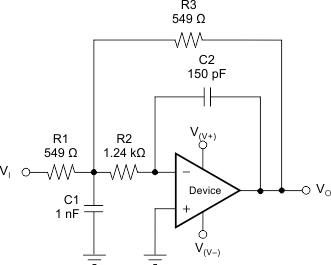JAJSFG4C December 2013 – May 2018 OPA355-Q1
PRODUCTION DATA.
- 1 特長
- 2 アプリケーション
- 3 概要
- 4 改訂履歴
- 5 Device Comparison Table
- 6 Pin Configuration and Functions
- 7 Specifications
- 8 Detailed Description
- 9 Application and Implementation
- 10Power Supply Recommendations
- 11Layout
- 12デバイスおよびドキュメントのサポート
- 13メカニカル、パッケージ、および注文情報
パッケージ・オプション
デバイスごとのパッケージ図は、PDF版データシートをご参照ください。
メカニカル・データ(パッケージ|ピン)
- DBV|6
サーマルパッド・メカニカル・データ
発注情報
9.2.4 Active Filter
The OPA355-Q1 device is designed for active filter applications that require a wide bandwidth, fast slew rate, low-noise, single-supply operational amplifier. Figure 36 shows a 500 kHz, second-order, low-pass filter using the multiple-feedback (MFB) topology. The components are selected to provide a maximally-flat Butterworth response. Beyond the cutoff frequency, roll-off is –40 dB/dec. The Butterworth response is preferred for applications requiring predictable gain characteristics, such as the anti-aliasing filter used in front of an ADC.
One point to observe when considering the MFB filter is that the output is inverted, relative to the input. If this inversion is not required, or not desired, a noninverting output can be achieved through one of the following options:
- Adding an inverting amplifier
- Adding an additional second-order MFB stage
- Using a noninverting filter topology, such as the Sallen-Key (see Figure 37).
MFB and Sallen-Key, low-pass and high-pass filter synthesis is quickly accomplished using TI’s FilterPro™ program. This software is available as a free download at www.ti.com.
 Figure 36. Second-Order Butterworth 500-kHz Low-Pass Filter
Figure 36. Second-Order Butterworth 500-kHz Low-Pass Filter  Figure 37. OPA355-Q1 Configured as a Three-Pole, 20-kHz, Sallen-Key Filter
Figure 37. OPA355-Q1 Configured as a Three-Pole, 20-kHz, Sallen-Key Filter